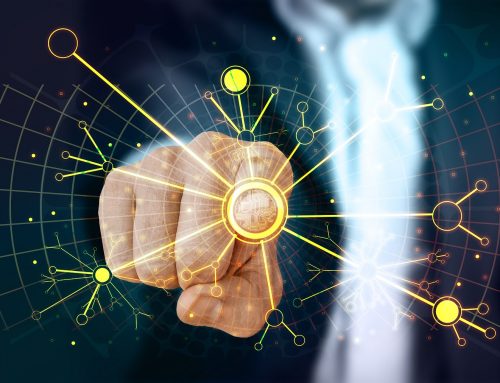“Fashion and Artificial Intelligence” – at first it sounds like something out of a sci-fi movie or a novel. It sounds as words that shouldn’t be even put in the same sentence, let alone be put together in real life. In the past it would certainly evoke reactions like “Fashion and what? Oh God, why? Quick, put the baby in the mini-van!” So do opposites really attract or are fashion and AI the worst match made in hell?
In the past fashion retailers were something not short of explorers, with a need to adjust to customers’ ever changing tastes and behavior. Nowadays those tastes and behavior are being pushed by numerous factors like customization, financial markets, sustainability concerns, information society, and globalization. We no longer live and work in small bubbles and in order to keep up, we have to evolve.
We are witnesses to a next industrial revolution where no area of life or business will be able to exist without AI. Fashion is no exception. Its future will be shaped, whether it likes it or not, to a large extent by AI and machine learning technology.
And although it may seem like an unlikely friendship at first – one being all glamourous, artistic, and, let’s be honest, sometimes kind of self-important, bias and snobbish, the other being all cold, reserved and fact-oriented, it is a universal truth that we live our lives in both of them so it seems only natural for those two industries to join forces to conquer the world – well, at least our worlds.
Having said all that, how exactly can AI help fashion industry? What are the benefits of such “friendship”? Let’s start by describing some of the most common AI trends that can be observed lately in fashion industry.

image source: https://www.sanpeiventures.com/fashion-ai-in-action-season-ii/https_blogs-images-forbes-comjeanbaptistefiles201803heuritech-image-technology/
Crystal Ball Fortune Teller
Information rules the world. Well, at least the right information does. It is also no secret that any business, fashion design included, is based greatly on trends and predicting them for the foreseeable future.
But wrong forecasting can easily lead to wrong designs and wrong strategic decisions, what furthermore translates into huge amounts of lost money, time and effort, and no business is rich enough to allow itself that kind of luxury. In the past retailers based their decision making process on their experience but it is no longer enough. Here AI can come to the rescue, being able to make market and trend predictions like a human would.
We live in the era of social media, no one can deny it. Sometimes the first thing we do in the morning is catching up what’s new on Facebook or Instagram. And although walking with your face glued to a mobile screen is hardly a thing to be proud of, we cannot argue the fact that social media and other data sources of such kind provide literally tons of information that can be analyzed to make trends’ predictions. And as for a human such task would be time- and energy-consuming, AI can do it faster (and probably better) and this way help in making better decisions in terms of designs, plan merchandising strategies and marketing campaigns, avoiding missed sales opportunities and efficiencies. Thanks to AI, companies can produce new apparel faster and with a higher market’s needs matching ratio, hence becoming more profitable.
Matchmaker, matchmaker, make me a match

image source: https://tonbarbier.com/2014/04/22/asap54-le-shazam-de-la-mode-qui-va-te-ruiner/
But all that still does not guarantee success, the product still needs to simply be seen and desired by customer. And how often has it happened to you as a customer that after minutes (heck! sometimes hours) of cruising through the Internet or a particular website you fail to find the item you are looking for? Or after finally finding the item it is only to find out for it to be out of stock, not in the right size or not exactly it? Just think of all this wasted time and effort. You abandon the website disappointed. Hopes, dreams, time, energy and money are lost on both sides. But where there is a problem, there is also a solution, and it is called visual recognition.
Thanks to AI specialists similar product recommendations, based strictly on the visual similarities of the item, are now often being used on the detail pages of online stores. Through computer vision and algorithms customers can be given suggestions of similar items to those they are looking for. Moreover customer can take a photo, upload it and the AI-powered algorithm, for example provided by Promity, identifies the pictured product (or similar ones) across multiple sites and retailer’s catalogs. Visual features are extracted by an automatic image tagging tool and recommend appropriate tags categories and attributes to new products when adding them to the store – a task which used to be carried out manually in the past. Moreover, translation of those attributes can be automated by analyzing product images, updates can be made as many as several times a day.
Brand new collection from a hot AI-designer
So are designers to be afraid of AI? Are they going to be out of work pretty soon? Do they have countless sleepless nights ahead of them?
No worries, ain’t gonna happen, at least not as fast as you may think. Fashion is all about people, ok – it’s more about clothes but people wear those clothes so it all comes down to people’s emotions, feelings and this human touch, perspective and creativity that will never go out of style.
But as there is always place for improvement so can designer’s work be enhanced by AI, for example by reducing the number of mundane tasks and leaving more time for the creative bits. Because if machines can recommend clothing attributes that are searched for by customers, why shouldn’t they be able to combine the above mentioned attributes into one design? Amazon is already on it – from numerous photos of clothes, all in one particular style, they are trying to teach an AI designer to be able to create one new item of clothing.
On the other hand Here and Now brand (a part of Myntra’s fashion brands) increased sales by several percent by introducing T-shirts designed by AI.
And when AI will never be truly able to fill in a designer’s shoes entirely, it can become a sort of assistant to a fashion designer, looking for right fabrics, new trends, color combos, sustainable fabric combinations or advising what a designer/company is missing in general and what is currently of interest to customers.
Here comes….Personalization
One thing that is always of interest to all customers is the need to feel special. As customers we want to be cherished, pampered but above all we don’t want an online store to waste our valuable time. We want it in stock, we want it in right size and we want it now.
And this is where AI solutions come to the front to make our dreams come true and at the same time bring higher profit and conversion to fashion companies – isn’t that just fab?
One way of doing so is through AI virtual assistant aka AI chatbots. These machines are created to mimic customer service agents by being fed with data and learning from each interaction, providing more relevant recommendations one conversation at a time. This way a company can increase its purchases, save money on customer service staff and at the same time build customer loyalty. Sweet…
AI-powered recommendation engines can also, by taking into account behavioral data, provide personalized product recommendations in the form of “You may also like/Customers also bought”. Maybe it is not perfect yet but it is getting there. Slowly but surely.
Moreover, by taking on a shape of virtual stylist and with a real human stylist as their loyal sidekick, AI can help us find the right size/fit/stretch by learning what suits each of company’s customers best according to their body type. By filling out an online profile, the system is able to recommend the best items for us, sorting through numerous combinations of clothing. Companies approach the concept of virtual stylist in all sorts of ways. Matchesfashion.com is for example experimenting with 3D avatars that are supposed to try on digital samples of clothing of our choice. Stitch Fix company has a bit different business style, they send their customers personalized items’ collection every month and by keeping feedback of what customers keep and what they return, they increase their collection’s accuracy with every single recommendation. It is a perfect solution to one of the worst problems of apparel brands – returns. Returns in fashion companies take a lot of time to inspect, clothes are often damaged and cannot be sold again. It could all have been prevented if only customers could have made an informed decision based on good pictures, descriptions and enough detail.
Devil is in the detail
And what if after all those solutions, all those carefully planned and executed designs and personalization methods we are still not satisfied with our results? We can always turn our hopeful eyes to customer purchase prediction and ideal price recommendations, as it is the small stuff that make a difference. But what do those words actually mean?
With specially designed algorithms analyzing the number of visits to product pages, the frequency of newsletter opens etc., we can predict whether a customer is going to make a purchase or not, in other words if the number of “clicks” on our page is likely to generate income. It also allows companies to tailor discounts accordingly, maximize profits by slightly increasing prices and do all sorts of other astounding business magic tricks.
What’s more, AI can help companies to stay competitive even with such giants as Amazon or Asos on the market. Using freely available data, AI monitors our competitors’ product prices and gives us recommendations about ideal price points to improve our revenue when faced with changes in external factors such as retailer’s inventory for example.

https://exponea.com/e-books/ai-ebook/
A storehouse full of clothes and nothing to sell
Managing inventory can be a real pain for apparel brands. Fashion companies tend to have a lot of capital invested in it, they need to keep the business going so they have to have enough stock but at the same time they have to be very careful not to end up with stacks of unsold merchandise. With the help of AI algorithms, using historical data and taking into consideration the upcoming trends and retailer’s “need” to sell older stock, AI can decrease the number of forecasting errors by accurately predicting demand and reduce companies’ inventory at the same time.
All those cases are of course the tip of an iceberg and much more can be done by engaging AI into our proceedings in the future. There are also numerous ways for technology to increase foot traffic in brick and mortar stores – however that is a topic for an entirely different article…
So finally, we are here! At the end of this article! There is still one crucial thing to do and namely answer the big question from the very beginning – “Are fashion and AI friends or foes?” Well, as you could have guessed by now, as things seem to be evolving, the chances that they are going to remain in contact, be friends and with time even become BFF are pretty good. AI is gradually becoming a major requirement in every business in order not to be left behind and fall off the edge of the business Earth. Fashion, where increase in sales is strictly connected with a customer’s smooth journey and positive overall experience, is also in that group. With time tasks executed with AI will surely grow in complexity, speed and precision so companies who adopted the new technologies are going to be raising the bar pretty effectively and constantly. Together fashion and AI can turn into a real power couple – enhancing each other’s strengths and possibilities, and rooting out the weaknesses.
We may not like it, we may not love it, but we’d better get used to it, because this relationship is definitely here to stay folks.



